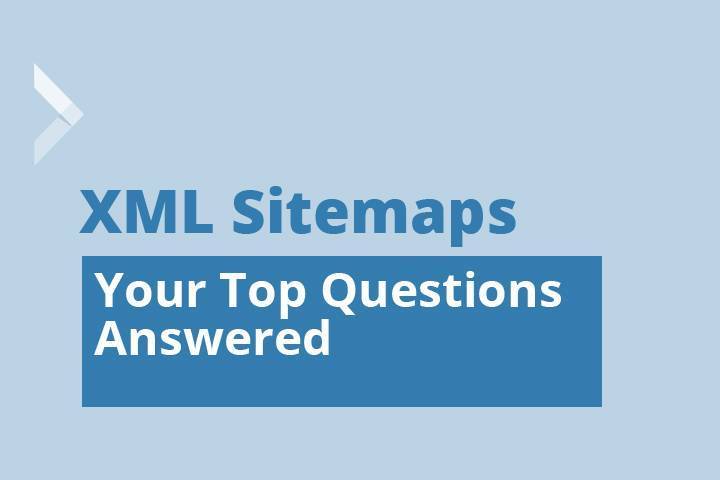

Sitemaps: Your Top Questions Answered

Sitemaps are a crucial tool for webmasters. There are three main types of sitemaps: XML sitemaps, HTML sitemaps, and visual sitemaps used for web strategy. We’ve compiled a list of questions and answers about sitemaps below. Enjoy!
1.What’s a sitemap?
A sitemap is a list of a website’s pages. It’s a sort of “table of contents” for a website that allows you to see every page on your site. Some sitemaps are purely visual and used to show a hierarchy of information on your page. They play a big role in website strategy and can be useful when planning the hierarchy of information on your website or when looking for the area of your website where you have a lot of site bloat (excess, unuseful pages). Many webmasters include HTML sitemaps on their websites to make navigation around the site easy for people using screen readers. Often, when people refer to sitemaps they are thinking of XML sitemaps, a file-based sitemap hosted on a website that help Google, Bing, and other web crawlers find and index your site properly.
2. What is an XML sitemap?
An XML sitemap is a standard web protocol that allow search engines like Google and Bing easily index and understand your site. When used correctly, they prevent search engines from accidentally skipping over pages in your site. This ensures every page can be found through traditional, organic search.
3. Are sitemaps still important?
If you want to ensure all the pages in your website can be found by search engines, you’ll definitely want an XML sitemap. If you’re planning a new website or updating your current website, sitemaps are an excellent strategic tool to plan out URL structure, information hierarchy, and content. HTML sitemaps aren’t a necessity if you’ve designed a site that’s easy to navigate. However, if you want your site to be fully accessible, an HTML sitemap is generally considered a best practice.
4. Do I need an XML sitemap?
Yes. If you want to ensure your site can be found in search engines, an XML sitemap is essential. Google mentions the following cases that sitemaps are a must:
- Large sites - large sites are more likely to have new or updated pages overlooked during search engine’s regular crawling
- New sites - new sites with few external links pointing to it are less likely to be crawled (search engine crawlers crawl the web my following links from one website to another website). If you’ve just launched a new brand or website, you’ll want to make sure you have a sitemap.
- Sites with minimal interlinking - some sites have a lot of archived pages or sections of your site that exist in silos. These sites definitely need XML sitemaps because search engines can’t easily follow links around your site. (One way to know if this applies to you is if you have a section of your site that you can’t access from your homepage.)
- Sites frequently posting new content - if you’re consistently publishing new pages, articles, or features on your site, a well maintained sitemap will make sure search engines are up to date on your website’s pages.
Although smaller, established websites may be indexed properly without a sitemap, you will never be penalized for having a sitemap. That’s why it’s widely viewed as a best practice for web developers.
5. Do sitemaps help SEO?
Yes. XML sitemaps ensure Google, Bing, and other search engines see and index every page on your website. If you’re trying to grow organic traffic to your site, it’s critical that people can find any page on your website through searches. Sitemaps do not affect your ranking on keywords. Rather, they affect whether a page has the chance to rank at all!
6. How do I add a sitemap to Wordpress?
You will need to use a plugin to create an XML sitemap because wordpress sites do not automatically create sitemaps for your sites. We recommend using Yoast, a full-service SEO tool that helps you manage a wide range of SEO tasks, from meta descriptions to keywords to sitemaps. It’s standard for almost all of our client’s sites we design using wordpress.
To add your sitemap to your website with Yoast:
- Install the Yoast plugin to your wordpress site.
- Under “SEO” click “XML sitemap.”
- Check the box to enable the functionality, and voila!
The best part of Yoast’s sitemap function is that it updates automatically as you add new posts or pages to your site. Your sitemap will always be up-to-date, allowing search engine crawlers to always find and index your site.
7. How often do I have to update my XML sitemap?
If you are manually creating and updating your sitemap, you’ll want to refresh it occasionally when you add additional content to your website.
8. What’s a sitemap index?
Sites with more than 50,000 URLs need to use linked index files to manage their large sitemaps. You can find good information about this at sitemaps.org. (https://www.sitemaps.org/protocol.html#index)
9. How do I register my sitemap with Google?
Within Google Search Console for your site, click on “crawl” on the left and then on “Sitemaps.” Submit the URL for your sitemap in the box provided.




